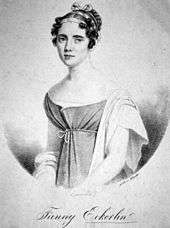Fanny Eckerlin

Fanny Eckerlin (1802–1842) was an Italian mezzo-soprano who also sang contralto roles. During her career she was highly regarded, drawing favorable comparisons to Benedetta Rosmunda Pisaroni, but today she is remembered, if at all, for her association with the early career of Gaetano Donizetti, including creating the title role in his first publicly-performed opera, Enrico di Borgogna.[1]
Eckerlin's father was a Napoleonic official of Polish origin; her mother, an Italian, was a sister of the actress Teresa Pichler, whose husband was the poet Vincenzo Monti.[2] A native of Milan,[3] she studied at the Milan Conservatory under David Banderali.[4] At the age of sixteen in 1818 she made her debut in L'Italiana in Algeri of Gioacchino Rossini at the Teatro San Benedetto in Venice; it was later that same year, on November 14, that she created the title role of Donizetti's Enrico di Borgogna at the Teatro San Luca, in the same city.[1] Her performance on this occasion was overshadowed by the indisposition, through stage fright, of the prima donna, Adelina Catalani, and the surviving review from Nuovo Osservatore Veneziano makes almost no mention of her appearance.[5]
On December 15 of the following month, also at the Teatro San Luca, Eckerlin created the role of Enrico in Donizetti's Una follia, a now-lost opera buffa based on the same libretto as the previous work.[6] She created one further role for Donizetti, that of Serafina in his comedy Le nozze in villa. That opera premiered at the Teatro Vecchio in Mantua during the carnival season of 1820–1821. It was not a success; Bartolomeo Merelli, the librettist, later blamed Eckerlin in part for its failure, writing in his Cenni biografici that the piece had faltered due to the "caprices and ill will of several of the singers, especially the prima donna".[7] William Ashbrook has speculated on this last point that Eckerlin may have been chafing at the restrictions of her contract, as by this time she had already appeared with some success at La Scala,[8] where she had debuted in La gazza ladra during the 1817–18 season.[9]
During Eckerlin's career she spent several seasons at the Teatro Italiano in Barcelona, where a claque in her honor was created,[10] and where she won many favorable notices for her work before accepting a contract with the Salle Favart in Paris.[4] She was a noted interpreter of Rossini,[1] and during his tenure at the helm of the Théâtre Italien she appeared there in a number of roles, among them creating Angelina in La cenerentola at its Paris premiere alongside Giovanni Battista Rubini and Fanny Tacchinardi Persiani.[11] At the same theater she appeared as Arsace in Semiramide in 1832 when Giulia Grisi made her Paris debut in the title role.[12] Eckerlin's career also took her to the Teatro Regio in Turin[3] and the Teatro di San Carlo in Naples, at both of which she appeared in leading roles.[13] She sang, too, in Vienna, where with Domenico Barbaja's company in 1822[12] she created the role of Emma in the local premiere of Rossini's Zelmira, a performance for which, for her, the composer wrote a new aria, "Ciel pietoso, ciel clemente", to be inserted into the second act.[7][14] She appeared also in Madrid and London during her career.[10][9]
Eckerlin had an extensive range, and was noted as well for her coloratura.[1] She was said to possess "a sweet contralto", and one critic, writing in the Gazetta di Milano of February 4, 1817, spoke of her as having "fine means and no ordinary taste in singing."[5]
References
- 1 2 3 4 Dan H. Marek (20 October 2016). Alto: The Voice of Bel Canto. Rowman & Littlefield Publishers. pp. 151–. ISBN 978-1-4422-3589-2.
- ↑ Gianluca Albergoni (2006). I mestieri delle lettere tra istituzioni e mercato: vivere e scrivere a Milano nella prima metà dell'Ottocento. FrancoAngeli. pp. 373–. ISBN 978-88-464-7392-9.
- 1 2 Alberto Basso; Marie-Thérèse Bouquet-Boyer (1976). Storia del Teatro regio di Torino. Cassa di risparmio di Torino.
- 1 2 The Harmonicon. W. Pinnock. 1828. pp. 1–.
- 1 2 Liner notes to A Hundred Years of Italian Opera 1810–1820, Opera Rara
- ↑ Casaglia, Gherardo (2005).[http://almanac-gherardo-casaglia.com/index.php?Giorno=15&Mese=12&Anno=1818&Testo=Una_follia&Parola=Stringa "Una follia, 15 December 1818"]. L'Almanacco di Gherardo Casaglia (in Italian).
- 1 2 Charles Osborne (1 April 1994). The bel canto operas of Rossini, Donizetti, and Bellini. Amadeus Press. ISBN 978-0-931340-71-0.
- ↑ William Ashbrook (1965). Donizetti. Cassell.
- 1 2 Armin Schuster (2003). Die italienischen Opern Giacomo Meyerbeers. Tectum Verlag DE. pp. 159–. ISBN 978-3-8288-8504-2.
- 1 2 Joseph d'Ortigue; Sylvia L'Ecuyer Lacroix (2003). Écrits sur la musique 1827–1846. Société française de musicologie.
- ↑ Dan H. Marek (6 June 2013). Giovanni Battista Rubini and the Bel Canto Tenors: History and Technique. Scarecrow Press. pp. 3–. ISBN 978-0-8108-8668-1.
- 1 2 William Ashbrook (29 July 1983). Donizetti and His Operas. Cambridge University Press. ISBN 978-0-521-27663-4.
- ↑ Herbert Weinstock (1979). Donizetti and the world of opera in Italy, Paris, and Vienna in the first half of the nineteenth century. Octagon Books. ISBN 978-0-374-98337-6.
- ↑ Nicholas Mathew; Benjamin Walton (7 November 2013). The Invention of Beethoven and Rossini: Historiography, Analysis, Criticism. Cambridge University Press. pp. 167–. ISBN 978-0-521-76805-4.